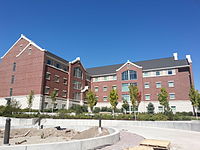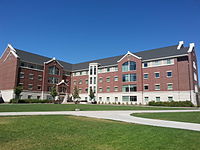This is a list of residential buildings at Brigham Young University which includes residential halls, dining facilities, housing area offices, laundry facilities, and other buildings directly connected with the residence halls. Residential buildings at Brigham Young University include three single-student residence hall centers, a foreign language student residence facility, and married-student housing at Wymount Terrace.
Foreign Language Student Residence
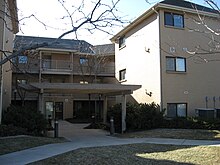
Brigham Young University's Foreign Language Student Residence (FLSR) program was established in 1978 as a three-house off-campus residence center dedicated to the study of Russian and Italian. Due to the success of these houses, the program expanded from three houses to one specially-designed complex in 1991. Each apartment houses 6 students: 5 students who are studying the same language and a native speaker. Each student agrees to only speak the apartment's assigned language during the school year while in the apartment.
Today the FLSR consists of five buildings- four outer buildings with three floors each. These contain all of the male and female apartments for the program. The central building has rooms used for student activities, dinners, and Sunday church meetings. The on-campus complex consists of 25 individual apartments for men and women learning eleven different languages (depending on demand): Hebrew, Chinese, French, German, Italian, Japanese, Portuguese, Russian, Korean, and Spanish.
Helaman Halls
Helaman Halls, named after one of the Book of Mormon heroes of the Church of Jesus Christ of Latter-day Saints, was first opened for use in the Fall of 1958. The initial on-campus complex consisted of five residence halls, a central dining building, and an administration building. Construction costs were $5,300,000, and when completed the complex initially housed 1170 male students. The residence buildings were named after prominent LDS individuals and/or families, including the Hinckley Family, Stephen L. Chipman, David John, Thomas N. Taylor, and Walter Stover.
The dining building was christened the George Q. Cannon Building and at the time could accommodate 1,800 people. In addition, both a pool and a "recreation field," which included eight tennis courts and four softball fields, were completed for the use of residents. Two more residence buildings were already under construction when the completion of the original Helaman Halls Complex was announced on September 18, 1958. The two new buildings were opened for use in September 1959, and housed 234 women each, bringing the total occupancy number of the complex to 1638. In 1959, the semester rent for Helaman halls was approximately $23 per term. Another building was added in 1970, and a new hall was built in 2010.
From 1991 to 2003, buildings at Helaman Halls underwent a 12-year renovations project so that each room would have a sink and vanity. Today, Helaman Halls has a total of nine residence buildings. with five buildings for women and four buildings for men. The Residence Halls are located on the northwest corner of campus. Living style consists of two students per room, with 22 rooms on each floor, with six floors (in three stories) per building. Helaman Halls currently has housing for just over 2,100 students. There are basic kitchen facilities in the basement lobby of each hall, but residents are required to purchase a meal plan. The majority of resident meals are eaten in the area central building- the Cannon Center. Because of its close proximity to the athletic facilities and all-you-can-eat dining, many Freshman athletes choose to live in Helaman Halls.
Notable individuals who lived at Helaman Halls include Mike Leach, Vai Sikahema, and Alema Harrington.
| Building | Abbr. | Image | Yr. Occ. | Notes |
|---|---|---|---|---|
| Cannon (George Q.) Center | CANC Center | 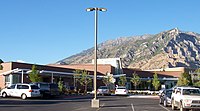 |
1958 (original); 2008 (current) | Named after George Q. Cannon, the Cannon Center acts as a central building for Helaman Halls residents, providing areas for activities, food services, meeting rooms, and maintenance services. Besides this, The Commons at the Cannon Center provides meal services for the residents of Helaman halls, and off-campus students; it serves as the main cafeteria for BYU since the 2008 closing of the Morris Center. Construction on the first Cannon Center began in 1957. The Cannon Center offers a variety of international foods, grilled options, and traditional meals. The Commons operates under a zero-food waste policy: food scraps are used to make fertilizers and used oil is converted to biodiesel. |
| Helaman Halls (B) Hinckley Hall | HLB |  |
1958 | Named after Ira N. Hinckley, the grandfather of the late President of The Church of Jesus Christ of Latter-day Saints Gordon B. Hinckley. |
| Helaman Halls (C) Chipman (Steven L.) Hall | HLC | 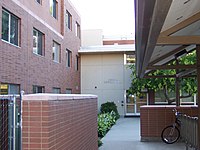 |
1958 | Named for Stephen L. Chipman, Mormon religious leader in north Utah County and member of the BYU Board of Trustees for over 40 years. |
| Helaman Halls (D) John (David) Hall | HLD |  |
1958 | Named after David John, father-in-law of Benjamin Cluff (third president of Brigham Young University) and vice-president of the Brigham Young Academy and Brigham Young University Board of Trustees. |
| Helaman Halls (E) Taylor (Thomas N.) Hall | HLE |  |
1958 | Named after Thomas N. Taylor, vice president of the Board of Trustees at the university. He oversaw fundraising efforts to finish paying for the Maeser Building. |
| Helaman Halls (F) Stover (Walter F.) Hall | HLF | 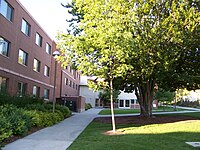 |
1958 | Named after Walter F. Stover who donated all the mattresses and box springs for Helaman Halls. Stover was a native of Germany and served as president of the East German mission immediately after World War II. He also served on the General Church Welfare Committee of The Church of Jesus Christ of Latter-day Saints. |
| Helaman Halls (G) Budge (William) Hall | HLG | 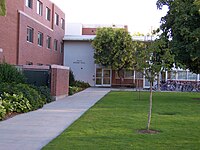 |
1959 | Named for William Budge, who was the missionary that helped convert Karl G. Maeser. |
| Helaman Halls (H) Merrill (Marriner Wood) Hall | HLH |  |
1959 | Named after LDS apostle Marriner W. Merrill. |
| Helaman Halls (I) May (Jean Fossum) Hall | HLI | 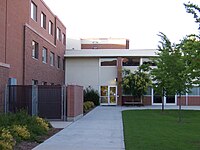 |
1970 | Named after Jean Fossum May (1906–1969), the head resident of Stover Hall for the last 10 years of her life. May had served a mission for the LDS Church when she was a little more than 20 years old. She greatly encouraged residents in her hall to serve missions and faithfully corresponded with them while they were on missions. |
| Helaman Halls (J) "Building 9" | HLJ | 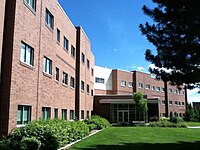 |
2010 | This facility lacks a basement kitchenette that the other residencies have. |
Heritage Halls
Heritage Halls were originally built in 1953. They were the oldest dorms on campus until they were torn down (see Previous Residential Facilities below) and replaced by the new Heritage Halls buildings. In order to make room for the new Heritage Halls buildings, the Deseret Towers "DT" apartment complex was also torn down from 2006 to 2008, and construction on the new buildings at the Heritage complex began in 2011.
Today, Heritage Halls is a complex of dorms that consists of 14 buildings, located on the East side of campus. In the summer of 2017, work was completed on a new central building and one additional dorm building, bringing the total capacity to about 2,750 students. Two additional dorm buildings are currently under construction.
The living arrangements in Heritage Halls are similar to those of an apartment. Students share a kitchen and a common area. Each of the L-shaped buildings houses about 210 students. They are 4 stories high and feature East Coast classic design. Activity rooms on each floor have pictures with Church history themes and have floor-to-ceiling windows that offer views of the surrounding area. The individual units feature full kitchens, bedrooms with individualized lighting systems, and hallway vanities.
The buildings in the Heritage Halls complex are as follows:
Wymount Terrace

Wymount Terrace is the family housing unit for married students and is located on the northeast side of campus. It consists of South Wymount (24 three-story apartment buildings) and North Wymount (48 two-story apartment buildings). The buildings are arranged in quadrangles that enclose lawn and playground areas. It is informally referred to as “the rabbit pen” by some students. This is possibly in reference to how fast families grow here. Wymount also has playground areas for children. Construction on the complex began in August 1961 by Tolboe and Harlin Construction Company. Each building has 462 apartments that range from one to three bedrooms. The complex sits on 27 acres.
| Building | Abbr. | Yr. Occ. | Notes |
|---|---|---|---|
| Wymount Terrace Administration Building | WOAB | 1962 | |
| Wymount Terrace Laundry Buildings 1-5 | W0L1, W0L2, W0L3, W0L4, W0L5 | 1962 (W0L1, W0L2, W0L3); 1979 (W0L4); 1985 (W0L5) | Each laundromat has standard and double-load washers and dryers along with two soak sinks. Machines can only be operated with a BYU ID card. |
| Wymount Terrace Multi-Purpose Center | W0MP | 1980 | This is where many of the wards consisting of Wymont residents hold church meetings. |
| Wymount Terrace (W01A) Kimball, (Sarah M.) | W01A | 1962 | Named for Sarah M. Kimball. |
| Wymount Terrace (W01B) Reynolds, (Alice Louise) | W01B | 1962 | Alice Louise Reynolds was a professor of English at BYU during the early 20th century. |
| Wymount Terrace (W01C) Smith (Julina Lambson) | W01C | 1962 | Julina Lambson Smith was a wife of Joseph F. Smith and the mother of Joseph Fielding Smith. |
| Wymount Terrace (W02A) Bennion (Samuel O.) | W02A | 1962 | Named for Samuel O. Bennion. |
| Wymount Terrace (W02B) Ivins (Antoine R.) | W02B | 1962 | Named for Antoine R. Ivins. |
| Wymount Terrace (W02C) Kimball (J. Golden) | W02C | 1962 | Named for J. Golden Kimball. |
| Wymount Terrace (W02D) Roberts (Brigham H.) | W02D | 1962 | Named for B. H. Roberts. |
| Wymount Terrace (W03A) Williams (Helen Spencer) | W03A | 1963 | Helen Spencer Williams, often called Helen S. Williams, was the first counselor in the YWMIA General Presidency of the Church of Jesus Christ of Latter-day Saints from 1937-1944. She was also a writer and columnists, writing for the Deseret News, the Improvement Era and the Relief Society Magazine. |
| Wymount Terrace (W04A) Nibley (Charles W.) | W04A | 1963 | Named for Charles W. Nibley. |
| Wymount Terrace (W04B) Reynolds (George) | W04B | 1963 | Named for Geoerge Reynolds. |
| Wymount Terrace (W04C) Wirthlin (Joseph L.) | W04C | 1963 | Named for Joseph L. Wirthlin. |
| Wymount Terrace (W04D) Young (Levi Edgar) | W04D | 1963 | Named for Levi Edgar Young. |
| Wymount Terrace (W05A) Clayton (William) | W05A | 1963 | Named for LDS hymnwriter William Clayton. |
| Wymount Terrace (W05B) Mcclellan (John J.) | W05B | 1963 | Named for John J. McClellan. |
| Wymount Terrace (W05C) Pratt (Orson) | W05C | 1963 | Named for Orson Pratt. |
| Wymount Terrace (W05D) Stephens (Evan) | W05D | 1963 | Named for former Mormon Tabernacle Choir director Evan Stephens. |
| Wymount Terrace (W06A) Dixon (Henry Aldous) | W06A | 1963 | Named for Henry Aldous Dixon a prominent Utah educator and politician. |
| Wymount Terrace (W06B) Hamblin (Jacob) | W06B | 1963 | Named for Mormon missionary to the Native Americans Jacob Hamblin. |
| Wymount Terrace (W06C) Sutherland (George) | W06C | 1963 | One of very few buildings at BYU named for a non-Mormon, in this case Brigham Young Academy graduate and later United States Supreme Court justice George Sutherland. |
| Wymount Terrace (W06D) Swensen (John C.) | W06D | 1963 | Named for John C. Swensen, a BYU professor for 54 years. |
| Wymount Terrace (W07A) Critchlow, Jr. (William J.) | W07A | 1962 | Named for William J. Critchlow Jr., a prominent LDS leader in Ogden and later a General Authority as an Assistant to the Twelve. |
| Wymount Terrace (W07B) Longden (John) | W07B | 1962 | Named for John Longden. |
| Wymount Terrace (W07C) McKay (Thomas E.) | W07C | 1962 | Named for Thomas E. McKay, a brother of David O. McKay who also served as a general authority. |
| Wymount Terrace (W07D) Smith (Nicholas G.) | W07D | 1962 | Named for Nicholas G. Smith. |
| Wymount Terrace (W08-W11) | - | 1979 | |
| Wymount Terrace (W12-W13) | - | 1982 | |
| Wymount Terrace (W14-W15) | - | 1985 | |
| Wymount Terrace (W16-W17) | - | 1992 |
Wyview Park

Wyview Park is a living complex for married and single students at BYU. The university had purchased 150 mobile home units to provide housing for married students until Wyview Park was built. Wyview was dedicated by James E. Faust. When the complex opened in 1998, it had a waiting list of 900 applicants which grew to 1,800 within a few months.

The current complex includes 30 buildings which originally housed married student families, until the end of the summer of 2006, when the southern half of the residential park was converted into housing for singles and eventually the entire complex. In 2013 after the winter semester of school concluded, the northern portion of Wyview was converted into a makeshift Missionary Training Center (MTC) to help alleviate the overburdened Provo MTC just up the hill. As part of this temporary MTC complex, the LDS church also obtained a lease for the Raintree Apartments across the street to the west and both facilities are used together to house missionaries and their training activities. The complex now houses both married and single students.
Previous Residential facilities
Allen Hall
One of the earliest student dormitories at BYU, Allen Hall, named for Ray Eugene Allen and his wife Inez Knight, was built in 1938. Originally it was a men's dormitory, but during World War II, a large influx of female students caused the university to make it a women's dorm. In 1962, the building ceased to be a student dormitory altogether, and was used as temporary housing for missionaries while the Church's Language Training Mission was under construction. The success of Allen Hall led to immediate plans for another dormitory, Amanda Knight Hall, named for the wife of Jesse Knight. This served as a home for female students until it was also turned over to the Language Training Mission.
BYA Boarding House
The BYA Boarding House was established in 1885 with Joseph B. Keeler as steward and Willard Done as presiding tutor. It had 24 residents in May 1886 but there is no record of it after that date.
Co-op Housing
In the years immediately after World War II BYU purchased several houses in Provo that it operated as co-operative residents before it was able to build resident halls on a large scale. Most of these houses were for female students.
Deseret Towers
In 1965, BYU completed construction of Deseret Towers. At the time it consisted of five halls, but a sixth was added in 1969 and the final in 1978. Each building was six stories and the whole complex housed over 2,000 students. Deseret Towers was dedicated in October 1970 by Ezra Taft Benson. The residential hall was referred to as "DT". In December 2006, V and W Hall were torn down because they didn't meet the electronic demands of students in the 21st century. After the winter semester the remaining buildings were used to hold conferences and did not serve as residential apartments anymore. They were demolished in 2008.
The following were halls at Deseret Towers:
- Ballard Hall (named after Melvin J. Ballard)
- Bennion Hall (named for Adam Samuel Bennion)
- Callis Hall (named for Charles A. Callis)
- Morris Center (named for George Q. Morris)
- Penrose Hall (named for Charles W. Penrose)
- Richards Hall (named for George Franklin Richards)
- Whitney Hall (named for Orson F. Whitney)
Old Heritage Halls
The original Heritage Halls complex was a twenty-four-building housing complex. Old Heritage Halls was completed in two stages: one stage of buildings were completed in 1953 and the other stage in 1956. The complex was dedicated on May 26, 1954. The halls received their collective name through a contest among residents. All of the separate buildings were named after notable Latter-day Saint women.
There were 24 individual living buildings. The Heritage Halls buildings were built for unmarried females, although later on males were allowed to be residents. At one point a "Homemaking Apartment" was located in Heritage Halls, where students in the Department of Home Economics and Management of the Home took turns living a low-budget lifestyle for two weeks at a time. Each of the buildings had ten units capable of housing six people each. This residential hall offered apartment-style living with kitchens included in each unit. In between the buildings there was a canal that was known as "the moat." Many students chose Old Heritage Halls due to its proximity to campus. The old residence halls began to be torn down gradually in 2005.
| Building | Abbr. | Image | Yr. Occ. | Notes |
|---|---|---|---|---|
| Heritage Halls Central Building | HRCN |  |
1983-2014 | This building contain a computer lab and the administrative offices for the complex. |
| Heritage Halls (01) Bowen (Emma Lucy Gates) Hall | HR01 |  |
1953-2011 | Named after Emma Lucy Gates Bowen. The school demolished Bowen Hall to make way for a new steam service tunnel between the Harris Fine Arts Center and 900 East. |
| Heritage Halls (02) Broadbent (Mima Murdock) Hall | HR02 |  |
1953-2015 | Mima Melissa Murdock Broadbent (1879–1957) was Utah State Mother of the Year in 1948. Mima and her husband David A. Broadbent were the parents of 14 children, 12 of whom lived to maturity. Broadbent Hall was one of the last four of the original Heritage Halls to be demolished, in 2015. |
| Heritage Halls (03) Felt (Louie B.) Hall | HR03 |  |
1953-2015 | Named after Louie B. Felt. |
| Heritage Halls (04) Fox (Ruth May) Hall | HR04 | 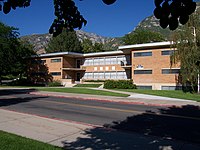 |
1953-2015 | Named after Ruth May Fox. |
| Heritage Halls (05) Horne (Alice Merrill) Hall | HR05 |  |
1953-2014 | Named for Alice Merrill Horne (1868–1948) who was a native of Fillmore, Utah and a prominent Utah artist. |
| Heritage Halls (06) Harris (Estella Spilsbury) Hall | HR06 |  |
1953-2015 | Named after Estella Spilsbury Harris who was the wife of Franklin S. Harris and thus the longest-serving first lady of BYU. |
| Heritage Halls (07) Maeser (Anna Mieth) Hall | HR07 |  |
1953-2014 | Named for Anna Mieth Maeser, wife of Karl G. Maeser, and thus first lady of what is now BYU from 1876–1892. |
| Heritage Halls (08) Penrose (Romania Pratt) Hall | HR08 | 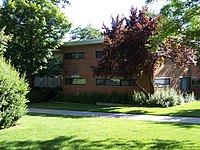 |
1953-2014 | Named for Romania B. Pratt Penrose, first female Utahn to get an MD and wife of Charles W. Penrose, who was a professor at BYU for a short time before becoming an LDS Apostle. |
| Heritage Halls (09) Rogers (Aurelia S.) Hall | HR09 | 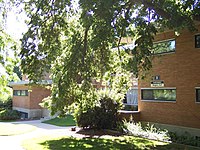 |
1953-2012 | Named after Aurelia Spencer Rogers, mother of the LDS Primary program for children and daughter of Orson Spencer, the first chancellor of what is today the University of Utah. |
| Heritage Halls (10) Richards (Alice Robinson) Hall | HR10 |  |
1953-2012 | Named after Alice Robinson Richards, wife of Apostle George F. Richards and mother of apostle Legrand Richards, as well as 14 other children. |
| Heritage Halls (11) Shipp (Ellis Reynolds) Hall | HR11 |  |
1953-2012 | Named after Ellis Reynolds Shipp. |
| Heritage Halls (12) Robinson (Louise Yates) Hall | HR12 |  |
1953-2012 | Named for Louise Y. Robison. |
| Heritage Halls (13) Snow (Eliza R.) Hall | HR13 |  |
1953-2012 | Named after Eliza R. Snow. |
| Heritage Halls (14) Smith (Lucy Mack) Hall | HR14 |  |
1953-2012 | Named after Lucy Mack Smith. |
| Heritage Halls (15) Wells (Emmeline B.) Hall | HR15 | 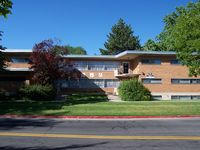 |
1953-2012 | Named after Emmeline B. Wells. |
| Heritage Halls (16) Smith (Mary Fielding) Hall | HR16 | 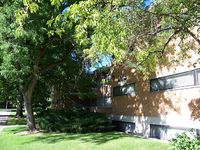 |
1953-2012 | Named after Mary Fielding Smith. |
| Heritage Halls (17) Carroll (Elsie C.) Hall | HR17 | 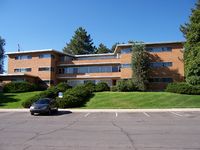 |
1956-2014 | Named after Elsie Chamberlain Carroll (1882–1967) who a BYU English professor and an author and poet, most of her works being published in LDS Church magazines. |
| Heritage Halls (18) Fugal (Lavina C.) Hall | HR18 | 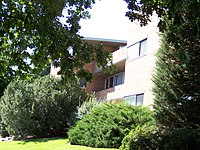 |
1956-2013 | Named after Lavina Christensen Fugal (1879–1969) who was American Mother of the Year in 1955. A graduate of Brigham Young Academy, Lavina taught school to help support her future husband, Jens Peter Fugal, while he was on an LDS mission in Denmark. The Fugals had eight children. She served in various LDS Auxiliary organization positions, was a member of the Farm Bureau, and served on the Utah County planning commission also for a time as head of the Pleasant Grove Board of Health. |
| Heritage Halls (19) Gates (Susa Young) Hall | HR19 | 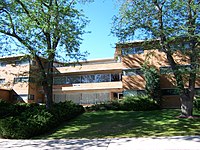 |
1956-2013 | Named after Susa Young Gates. |
| Heritage Halls (20) Kimball (Vilate M.) Hall | HR20 |  |
1956-2011 | Named after Vilate M. Kimball, the first wife of Heber C. Kimball, Brigham Young's best friend and also first counselor to Brigham Young in the first presidency until Heber C. Kimball died. |
| Heritage Halls (21) Richards (Emily S.) Hall | HR21 |  |
1956-2013 | Named after Emily Sophia Tanner Richards (1850–1929), the wife of Franklin S. Richards and a suffragist. She was a delegate for the Relief Society at the first International Council of Women. Emily served for many years on the Relief Society General Board. She and Franklin were the parents of six children. |
| Heritage Halls (22) Tingey (Martha H.) Hall | HR22 | 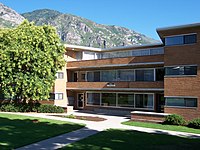 |
1956-2013 | Named after Martha H. Tingey. |
| Heritage Halls (23) Whitney (Elizabeth Ann) Hall | HR23 |  |
1956-2013 | Named for Elizabeth Ann Smith Whitney, the wife of Newel K. Whitney, the 2nd presiding bishop of the Church. |
| Heritage Halls (24) Young (Zina D. H.) Hall | HR24 | 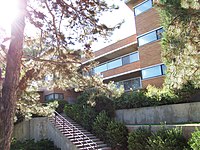 |
1956-2014 | Named after Zina D. H. Young. |
Wymount Village
In 1946, during the postwar BYU growth, President McDonald purchased forty-eight buildings from a nearby Air Force station in order to house students. These buildings were called Wymount Village, and housed both married and single students until 1962. Wymount Village was replaced by Wymount Terrace in that year, intended solely for students with young families. The 24 building complex contains a total of 462 apartments of varying sizes.
Wyview Village
This was another set of housing units purchased from the Federal Government. It was 150 pre-fabricated homes intended for Mountain Home Air Force Base. The units were practically new, with new appliances and many had never been lived in. They were sold as surplus by the government in October 1956, moved to Provo early in 1957 and ready for occupation by August 1957. They were located north-east of the present site of the Marriott Center.
References
- ^ Harker, Monica (February 26, 2011). "BYU's Language Studies: More than 60 Languages Offered". Church News. Provo, Utah. Archived from the original on August 18, 2016. Retrieved June 30, 2016.
- "BYU Foreign Language Housing". housing.byu.edu. Retrieved June 30, 2016.
- Andrus, Donna Lee. "Having Fun While Speaking French: A Foreign Language Housing Case Study". scholarsarchive.byu.edu. Retrieved June 30, 2016.
- Phillips, Cassidy (February 20, 2015). "FLSR Housing Offers International BYU Experience With Improvements Fall 2015". The Daily Universe. Provo, Utah. Retrieved June 30, 2016.
- ^ "Helaman Halls Dedication Slated Nov. 7". The Daily Herald. Provo, Utah. 2 November 1958. p. 24. Retrieved July 1, 2016.
- ^ "'Y' Opens $5 Million 'Home' for Men". The Daily Herald. 21 September 1958. p. 100. Retrieved July 1, 2016.
- "At BYU Residence Halls: Bubble Up for Winter Swim". The Daily Herald. 2 February 1977. p. 30. Retrieved July 1, 2016.
- "Construction Begins on New Recreation Field at BYU". The Daily Herald. Provo, Utah. 16 August 1959. p. 17. Retrieved July 1, 2016.
- "Names of Past Leaders Honor 'Y' Men's Halls:'Helaman Halls' Picked for Entire Group After Book of Mormon Hero Who Lead Liberty Fight". The Daily Herald. Provo, Utah. 18 September 1958. p. 24. Retrieved July 1, 2016.
- "Six Join 'Y' Faculty". The Daily Herald. Provo, Utah. 17 September 1959. p. 7. Retrieved July 1, 2016.
- "Excellent Housing Ready For 1959 Summer School". The Daily Herald. Provo, Utah. 13 May 1959. p. 24. Retrieved July 1, 2016.
- ^ "Dedication Ceremonies for 37 Buildings Will Be Held in BYU Fieldhouse OCt. 6". The Daily Herald. 28 Sep 1970. Retrieved 30 August 2016.
- Sorenson, Nedra (1 Sep 2014). "Dorm Life: Past and Present". BYU Newsletter. Brigham Young University. Retrieved 1 September 2016.
- Chamberlin, Sarah (30 Sep 2003). "A new home: Helaman Halls construction completed". BYU Newsnet. Archived from the original on 9 October 2003. Retrieved 2007-08-21.
- ^ "Accommodations". Brigham Young University. Retrieved 30 August 2016.
- Peavler, Lafe (30 June 2016). "Mike Leach Visits BYU Cafeteria". The Deseret News. Salt Lake City, Utah. Archived from the original on July 23, 2016. Retrieved July 1, 2016.
- Sikahema, Vai (October 26, 2015). "Vai's View: Late, Beloved Colleague was Ahead of his Time". The Deseret News. Salt Lake City, Utah. Archived from the original on October 30, 2015. Retrieved July 1, 2016.
- Robinson, Doug (13 June 2015). "Doug Robinson: Alema Harrington Finds Strength and his Mission in Helping Other Addicts". The Deseret News. Salt Lake City, Utah. Retrieved July 1, 2016.
- ^ Records of Naming and Dedicating Heritage and Helaman Halls. Provo, Utah: Brigham Young University.
- ^ Wilkinson, Ernest L. (1975). Brigham Young University: The First 100 Years. Vol. 2. Provo: Brigham Young University Press.
- ^ "BYU Opens New Cannon Center Dining Hall". Food Management. 30 July 2008. Retrieved 1 September 2016.
- "Morris Center to Close as Cafeteria". The Daily Universe. Brigham Young University. 6 Sep 2007. Retrieved 1 September 2016.
- "The Culinary Culture at BYU: Sustainable and Cost-Conscious". Food Management. 1 Mar 2009. Retrieved 1 September 2016.
- Ernest L. Wilkinson, ed. Brigham Young University: The First 100 Years (Provo: BYU Press, 1975) p. 573
- Leavitt, Melvin (May 1987). "Freely Given: Walter Stover—A Legend of Generosity". New Era. The Church of Jesus Christ of Latter-day Saints. Archived from the original on 2012-10-26.
- ^ "Dedications Tomorrow: Homecoming Week at 'Y' In Progress". The Daily Herald. 20 Oct 1959. Retrieved 29 August 2016.
- "Board Question #40644". Brigham Young University.
- "Helaman Halls". On-Campus Housing. Brigham Young University. Retrieved 29 August 2016.
- "Project Description". Big D Construction. Retrieved 29 August 2016.
- Volmar, Philip M. (21 Jan 2012). "Breaking down to build up the 'Spirit of the Y'". Church News. The Church of Jesus Christ of Latter-day Saints. Retrieved 29 August 2016.
- Gardner, Peter B. (Fall 2011). "100 Years on Temple Hill". BYU Magazine. Brigham Young University. Retrieved 30 August 2016.
- "BYU announces new Heritage Halls construction". Deseret News. Archived from the original on August 13, 2015. Retrieved 25 August 2015.
- ^ "New Heritage Dining facility built for visitors". The Daily Universe. Retrieved 31 January 2020.
- "Provo board approves new BYU Deseret Towers dorms". Deseret News. Archived from the original on April 5, 2013. Retrieved 26 August 2015.
- ^ "A New Heritage". BYU Magazine. Retrieved 26 August 2015.
- ^ "BYU announces new Heritage Halls construction". BYU News. Retrieved 31 January 2020.
- ^ "Heritage Halls". BYU On-Campus Housing. Retrieved 31 January 2020.
- "Wymount Terrace Facilities". Brigham Young University. Archived from the original on 13 March 2008. Retrieved 2008-05-25.
- "Wymount Terrace, 1960s". BYU Campus Photographs. Brigham Young University. Retrieved 30 August 2016.
- "Laundry Facilities". Services & Amenities. Brigham Young University. Retrieved 31 August 2016.
- "Wymount Terrace". On-Campus Housing. Brigham Young University. Retrieved 31 August 2016.
- Call, Jeff (2 Nov 1998). "New married housing is dedicated at BYU". Deseret News. Archived from the original on October 22, 2016. Retrieved 30 August 2016.
- Schaerr, Stephanie (5 Sep 2006). "Single Students Move in to Wyview". BYU Newsnet. Archived from the original on 2007-11-18. Retrieved 2007-08-21.
- Romboy, Dennis (28 March 2013). "LDS Church's temporary MTC will bring changes to apartment complex". Deseret News. Archived from the original on April 2, 2013. Retrieved 31 August 2016.
- "Allen Hall, 1938". BYU Campus Photographs. Brigham young University. Retrieved 2007-08-21.
- "Amanda Knight Hall, 1939". BYU Campus Photographs. Brigham young University. Retrieved 2007-08-21.
- Hatch and Miller. A History of BYU Campus. (Provo: BYU Grounds Department, 2001) p. 17
- Wilkinson. BYU First 100 years. Vol. 2, p. 669
- "Deseret Towers, ca. 1965". BYU Campus Photographs. Brigham young University. Retrieved 2007-08-21.
- ^ Romero, Irasema (12 Dec 2006). "W Hall Demolition Begins Early". BYU Newsnet. Archived from the original on 2 January 2007. Retrieved 2007-08-21.
- Kendall, Amy (8 Aug 2007). "Deseret Towers Facing Eventual Demolition". BYU Newsnet. Archived from the original on 18 November 2007. Retrieved 2007-08-21.
- Potter, Chealsea (19 Aug 2015). "Video captures demolition of BYU's final Heritage Halls buildings". Deseret News. Archived from the original on August 20, 2015. Retrieved 31 August 2016.
- ^ Keenan, Kate (26 Jan 2012). "Heritage Halls dorms at BYU have a long history of traditions". Brigham Young University. Retrieved 31 August 2016.
- McKay, David O. (1954-05-26). "Dedication". Brigham Young University. Retrieved 2008-05-25.
- ^ "Heritage Halls, group-living apartments for girls, ca. 1954". BYU Campus Photographs. Brigham young University. Retrieved 2007-08-21.
- ^ "Student housing complex demolished at BYU". Fox 13. 23 Jan 2014. Retrieved 29 August 2016.
- Hudson, Roy. "Lower Your Budget: Brigham Young University students show how to eat on an allowance of 50 to 65 cents a day". The Salt Lake Tribune. Retrieved 29 September 2016.
- Hogg, Emily (19 May 2011). "Bowen Hall set to be demolished" (PDF). The Daily Universe. Brigham Young University. Retrieved 31 August 2016.
- Utah History to go article on Fugal
- "Wymount Village, ca. 1953". BYU Campus Photographs. Brigham young University. Retrieved 2007-08-21.
- "Wymount Terrace, 1960s". BYU Campus Photographs. Brigham young University. Retrieved 2007-08-21.
Further reading
- Ernest L. Wilkinson., ed., Brigham Young University: The First 100 Years. Provo: Brigham Young University Press, 1975. 4 Volumes.
External links
- Foreign Language Student Residence Homepage
- Gender map of Helaman Halls
- Photograph of Wymount Terrace in the 1960s
- Article about Foreign Language Housing in The Daily Universe
- Photograph of Helaman Halls, ca. 1958
- Photograph of Heritage Halls and Wymount Village, UA P 2 Series 1 at L. Tom Perry Special Collections, Brigham Young University
- Photographs of Wyview Village
| Brigham Young University | |||||||||||||
|---|---|---|---|---|---|---|---|---|---|---|---|---|---|
| Academics | |||||||||||||
| Athletics | |||||||||||||
| Campus (buildings) |
| ||||||||||||
| History | |||||||||||||
| People | |||||||||||||
| Student life | |||||||||||||
| Organizations | |||||||||||||








